

|
 |
Fall (The): Series 2 (TV)
R2 - United Kingdom - Acorn Media Review written by and copyright: Paul Lewis (9th January 2015). |
|
The Film
  The Fall: Series Two The Fall: Series Two
The BBC’s serial killer-focused series The Fall (2013- ) has attracted much positive attention and, in its focus on a take-no-prisoners female detective, Superintendent Stella Gibson (played by Gillian Anderson, who is also appearing concurrently in the US serial killer series Hannibal, NBC, 2013- ), has invited comparisons with the portrayal of Detective Superintendent Jane Tennison (Helen Mirren) in Lynda La Plante’s groundbreaking Prime Suspect (Granada, 1991). (Interestingly, where Mirren was 45 when she played Tennison for the first time, Anderson was 44 when she took the role of Gibson.) In retrospect, this is unsurprising, given that The Fall’s creator, Allan Cubitt, wrote the second series of Prime Suspect in 1992. As the first series of The Falls established, Gibson has been relocated from London to Belfast, to head a task force that is charged with Operation Music Man: the hunt for the ‘Belfast Strangler’, a man who has been murdering young, dark-haired women. She is aided in this quest by Assistant Chief Constable Jim Burns (John Lynch), who is responsible for Gibson’s appointment as the head of Operation Music Man. Burns is a seasoned police officer who, it is suggested, has at some point in the past had an affair with Gibson. Gibson also enlists the support of Dani Ferrington (Niamh McGrady), a junior police officer who blames herself for the death of Sarah Kay, one of the Belfast Strangler’s victims whom Ferrington believes that, had she acted differently, she could have saved. 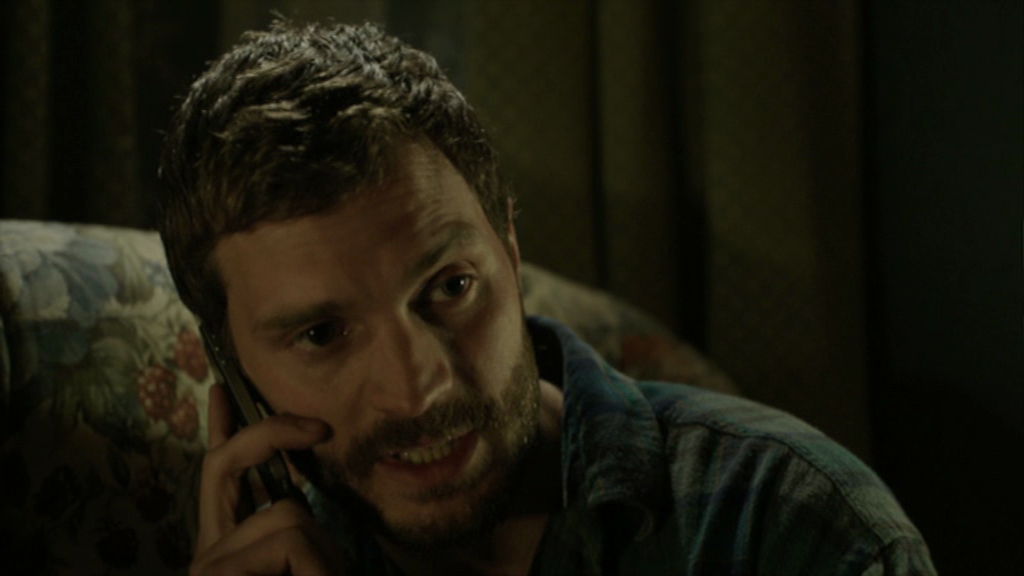 There’s little traditional suspense (at least, of a ‘whodunnit’ nature) within the central ongoing narrative of The Fall: the identity of the killer, grief counselor Paul Spector (Jamie Dornan), was established at the outset of the first series. The series follows the attempts of Gibson and her team to identify and catch Spector, alternating and juxtaposing Gibson’s story with that of Spector, her quarry. The Fall thus offers two protagonists who are on opposite sides of the law, somewhat recalling the work of Michael Mann - for example, his films Heat (1995) and Manhunter (1986); or, more pertinently, Mann’s groundbreaking series Crime Story (Michael Mann Productions/New World Television, 1986-8), which contrasted the life of Lieutenant Mike Torello (Dennis Farina) with the progression of up-and-coming gangster Ray Luca (Tony Denison). In The Fall, Spector is a family man: in the Daily Telegraph, Laura Thompson asserted that Spector is ‘an icon of perversity: a serial killer of lovely young women who resembles their natural mate, not their destroyer’ (2014: np). His relationship with his wife Sally-Ann (Bronagh Waugh) is taut, but he is loving towards his two young daughters. Spector’s domestic life becomes complicated by the intrusion of his 15 year old babysitter, Katie Benedetto (Aisling Franciosi), who has a fascination with Spector. There’s little traditional suspense (at least, of a ‘whodunnit’ nature) within the central ongoing narrative of The Fall: the identity of the killer, grief counselor Paul Spector (Jamie Dornan), was established at the outset of the first series. The series follows the attempts of Gibson and her team to identify and catch Spector, alternating and juxtaposing Gibson’s story with that of Spector, her quarry. The Fall thus offers two protagonists who are on opposite sides of the law, somewhat recalling the work of Michael Mann - for example, his films Heat (1995) and Manhunter (1986); or, more pertinently, Mann’s groundbreaking series Crime Story (Michael Mann Productions/New World Television, 1986-8), which contrasted the life of Lieutenant Mike Torello (Dennis Farina) with the progression of up-and-coming gangster Ray Luca (Tony Denison). In The Fall, Spector is a family man: in the Daily Telegraph, Laura Thompson asserted that Spector is ‘an icon of perversity: a serial killer of lovely young women who resembles their natural mate, not their destroyer’ (2014: np). His relationship with his wife Sally-Ann (Bronagh Waugh) is taut, but he is loving towards his two young daughters. Spector’s domestic life becomes complicated by the intrusion of his 15 year old babysitter, Katie Benedetto (Aisling Franciosi), who has a fascination with Spector.
At the end of the first series, Spector left behind a survivor, Annie Brawley (Karen Hassan). Meanwhile, as the police seem to be closing in on him, Spector and Sally-Ann separated, with Spector fleeing to Scotland. This second series opens with Gibson attempting to encourage Brawley to recall her attack and the identity of her attempted killer, as Rose Stagg (Valene Kane), a former lover of Spector’s on whom the future Belfast Strangler practiced autoerotic asphyxiation during their relationship, helps Gibson identify Spector as the killer she seeks. Returning to Belfast, Spector abducts Stagg. In Belfast, Spector maneuvers himself into the position of acting as the grief counselor for Annie Brawley. Spector also finds himself the target of Katie Benedetto’s attentions. Katie seems to exhibit a bizarre erotic fascination with Spector, though she tells Sally-Ann that Spector tried to rape her. Spector takes advantage of Katie’s sexual interest in him, grooming her into being his accomplice. Spector also sneaks into the hotel room in which Gibson is living during her stay in Belfast, and he reads (and, using his mobile telephone, photographs) the dream diary that she keeps – which offers him a window into the worldview of the woman who is hunting him.  Where the series ‘works’ is in making Spector sympathetic, rather than demonising him (he clearly loves his two daughters, for example). The series also works in drawing similarities between Gibson and Spector – the hunter and the hunted. Though this is a recurring trope within crime fiction that can be traced back to Victorian detective stories (for example, and perhaps most famously, the relationship between Sherlock Holmes and Moriarty in Sir Arthur Conan Doyle’s stories), The Falls treads this well-worn path in a very efficient manner: both Gibson and Spector are solitary and athletic, with the former running and the latter swimming (both activities depicted carefully within the series), and both characters are analytical in their approach to the world. This comes to the foreground in series two, when Spector sneaks into Gibson’s hotel room and reads her dream diary, seeing it as a chance to offer insight into the woman who has been attempting to catch him through her own application of psychoanalytic theory. As the episodes increasingly cut between Gibson and Spector’s stories, the similarities between the two characters become increasingly prominent. Where the series ‘works’ is in making Spector sympathetic, rather than demonising him (he clearly loves his two daughters, for example). The series also works in drawing similarities between Gibson and Spector – the hunter and the hunted. Though this is a recurring trope within crime fiction that can be traced back to Victorian detective stories (for example, and perhaps most famously, the relationship between Sherlock Holmes and Moriarty in Sir Arthur Conan Doyle’s stories), The Falls treads this well-worn path in a very efficient manner: both Gibson and Spector are solitary and athletic, with the former running and the latter swimming (both activities depicted carefully within the series), and both characters are analytical in their approach to the world. This comes to the foreground in series two, when Spector sneaks into Gibson’s hotel room and reads her dream diary, seeing it as a chance to offer insight into the woman who has been attempting to catch him through her own application of psychoanalytic theory. As the episodes increasingly cut between Gibson and Spector’s stories, the similarities between the two characters become increasingly prominent.
Spector isn’t the stereotypical serial murderer to be found in television and film; he’s able to quote Camus to Katie, for example. In a number of sequences, Spector and Katie communicate with one another via webcam, and at one point, in a very uncomfortable sequence, have cybersex – a further symbol of the alienation they both experience. (Spector’s relationship with Katie, and its use of new technologies, has some parallels with the current US television series The Following, 2013- , which features the acolytes of a serial killer who are brought together as a virtual community and then inspired/commanded to commit acts of copycat violence.) In one webcam conversation, Spector tells his young acolyte, ‘Maybe it’s time to take the next step [….] Are you ready to face the darkness’, explaining his philosophy to her: ‘There’s suffering all around us. Why not take some pleasure from it? [….] If other people’s happiness pains us, why not reduce that happiness?’ Neither is Gibson a stereotypical police officer. She is an interesting character, unafraid of her sexuality: in the first episode of series one, she seduced a junior colleague, DS James Olson (Ben Peel), who was later murdered, leading to questions about Gibson’s relationship with Olson that overshadowed her investigation into Spector’s crimes. In series two, Gibson’s female colleague, Dr Reed Smith (Archie Panjabi), is approached by a male lecher in the lobby of Gibson’s hotel, and Gibson helps Smith to elide the attentions of this man by planting a passionate kiss on her lips, then telling the man (who is holding two glasses, one for him and another for Smith), ‘Keep them [the drinks] coming’. ‘I’m not the waiter’, the man protests. ‘Then why are you standing there?’, Gibson asks him confrontationally. Gibson then invites Smith to her hotel room; Smith turns her down, telling Gibson, ‘I can’t. I was brought up in Croydon’. 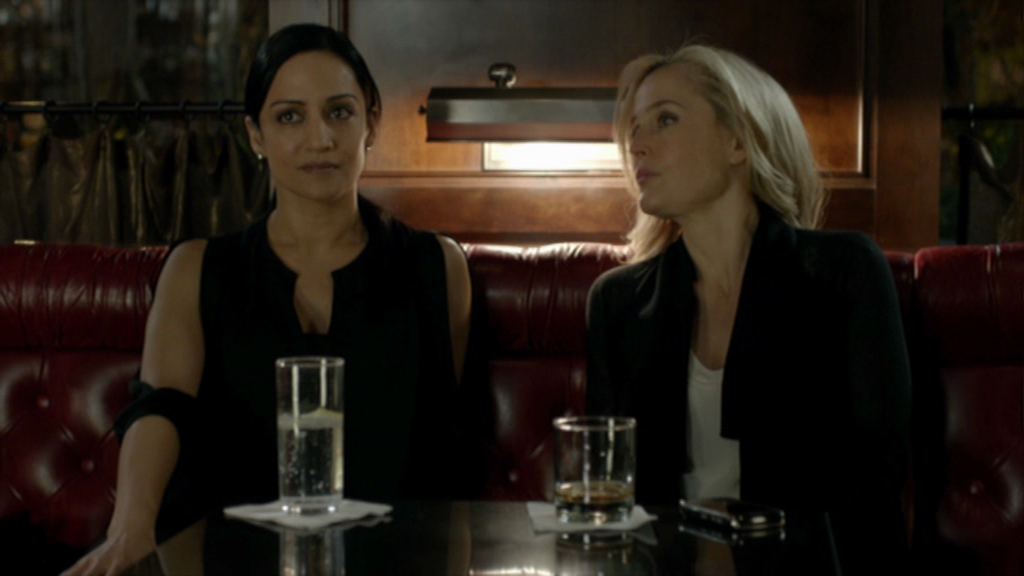 Gibson also evidences a curious misandry. When Spector steals into Gibson’s room and reads her dream diary, he leaves a note for her suggesting that she is a misandrist who is ‘lashing out against the world of men’ and who ‘miss[es] her daddy’. In the same sequence, Jim bursts into Gibson’s hotel room and, making a pass at her, which is quickly rebuffed, asks, ‘Why are women so much more emotionally stronger than men?’ To this, Gibson answers, ‘Because the basic human form is female. Maleness is… a kind of birth defect’. Gibson also evidences a curious misandry. When Spector steals into Gibson’s room and reads her dream diary, he leaves a note for her suggesting that she is a misandrist who is ‘lashing out against the world of men’ and who ‘miss[es] her daddy’. In the same sequence, Jim bursts into Gibson’s hotel room and, making a pass at her, which is quickly rebuffed, asks, ‘Why are women so much more emotionally stronger than men?’ To this, Gibson answers, ‘Because the basic human form is female. Maleness is… a kind of birth defect’.
Another interesting aspect of the series is the way in which it addresses and incorporates new technologies, something Twenty-First Century crime fiction has often struggled to do convincingly. Aside from the aforementioned webcam conversations between Katie and Spector, which seem to function as a symbol of these two characters’ alienation, in a number of sequences Spector is shown using the Internet, and in particular social media, to research his victims – for example, finding out about a potential victim after meeting her on the train, his brief conversation with her providing Spector with enough information to allow him to track her down via her online presence on social networks. Gibson herself, addressing her intensely private need to write down her dreams without sharing them with anyone else, addresses the proliferation of new communications technologies in her assertion that ‘Modern life is such an unholy mix of voyeurism and exhibitionism’. This seems to be a recurring, and fascinating, theme within this second series of The Fall. 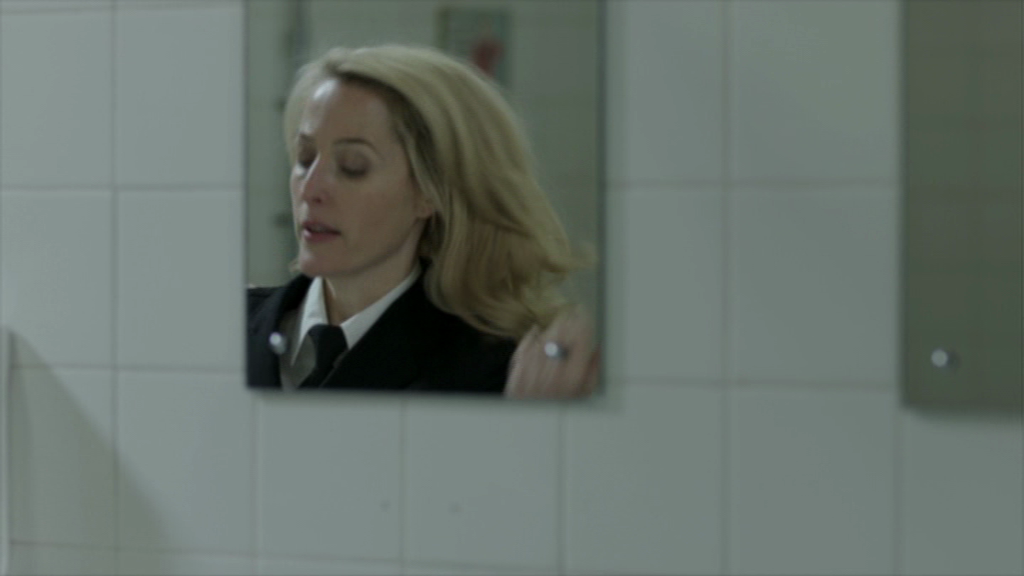 There’s some clunky, didactic dialogue from time to time: for example, in the aforementioned scene in which Smith is approached by a man in the lobby of Gibson’s hotel, she is asked ‘What do you do?’ ‘I’m a pathologist’, she responds, ‘From the Ancient Greek “pathos”, meaning disease, and “logos”, meaning a “treatise”. I study disease. Death being the final disease’. However, for the most part the series is convincingly acted and, in particular, very slickly photographed. An early sequence which depicts Gibson visiting a crime scene, alone and at night, is shot with chiaroscuro lighting that recalls the aesthetic of films noir. The series also uses a repeated visual motif, of Gibson and Spector (separately) standing in front of mirrors or reflections of themselves, suggesting duality of identity and complexity of purpose, as well as establishing the similarities between them. There’s some clunky, didactic dialogue from time to time: for example, in the aforementioned scene in which Smith is approached by a man in the lobby of Gibson’s hotel, she is asked ‘What do you do?’ ‘I’m a pathologist’, she responds, ‘From the Ancient Greek “pathos”, meaning disease, and “logos”, meaning a “treatise”. I study disease. Death being the final disease’. However, for the most part the series is convincingly acted and, in particular, very slickly photographed. An early sequence which depicts Gibson visiting a crime scene, alone and at night, is shot with chiaroscuro lighting that recalls the aesthetic of films noir. The series also uses a repeated visual motif, of Gibson and Spector (separately) standing in front of mirrors or reflections of themselves, suggesting duality of identity and complexity of purpose, as well as establishing the similarities between them.
Video
The Fall is shot digitally (on Arri Alexa cameras, apparently), and is presented her in its broadcast aspect ratio of 1.78:1, with anamorphic enhancement. The digital photography has a crisp, clinical quality to it and, despite some expressive lighting within the original photography, seems fairly low contrast – though this may be different for the Blu-ray presentation, which has been released concurrently with this DVD set. On the whole, it’s a very modern-looking series, which translates smoothly to digital home video formats. 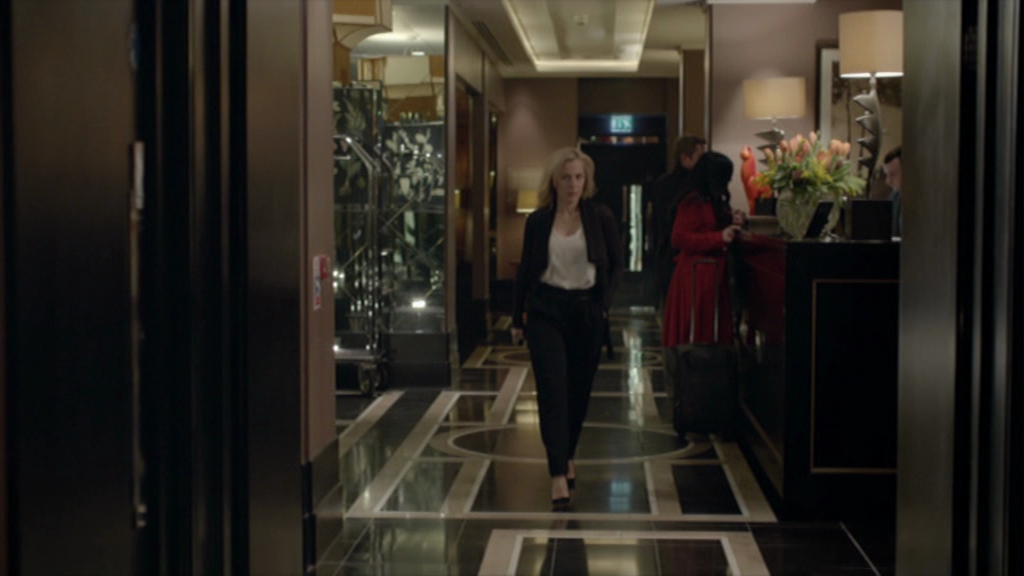
Audio
Audio is presented via a Dolby Digital 2.0 stereo track. This is clean throughout, subtle and rich in terms of its soundscape, and doesn’t present any issues. Optional English subtitles for the Hard of Hearing are included.
Extras
The disc contents are as follows: DISC ONE Episodes: - Episode 1 (59:22) - Episode 2 (59:05) - Episode 3 (58:45) "Behind the Scenes" featurette (11:35) Deleted Scenes (9:22) Picture Gallery (1:33) DISC TWO Episodes: - Episode 4 (59:03) - Episode 5 (58:13) - Episode 6 (89:37) Given some of the interesting ideas explored within the show, the behind the scene featurette is all too brief and constitutes little more than a promotional featurette: it would have been nice to see a more indepth critique of The Fall and/or a more thorough account of its genesis and production – or perhaps some reactions from both critics and fans, given the suggestions in some quarters that the series panders to misogynistic sentiment.
Overall
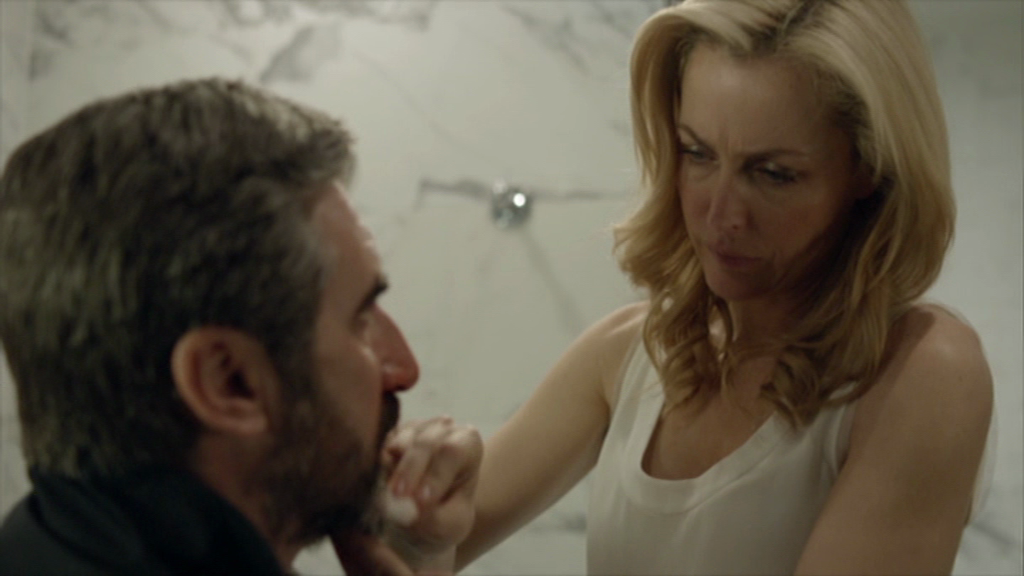 The Fall is a fascinating series which explores some interesting issues. Despite some occasionally clunky dialogue, the series is held together by some very strong performances and some superb photography. This release offers a strong presentation of the show’s second series, though first-time viewers will (naturally) be wiser to start with the first series. The Fall is a fascinating series which explores some interesting issues. Despite some occasionally clunky dialogue, the series is held together by some very strong performances and some superb photography. This release offers a strong presentation of the show’s second series, though first-time viewers will (naturally) be wiser to start with the first series.
References: Thompson, Laura, 2014: ‘From Miss Marple to The Fall – the rise and rise of women detectives’. The Daily Telegraph (13 Nov, 2014): np Available now on both DVD and Blu-ray.
|
|||||

|